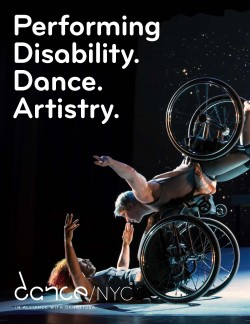Dance/NYC Publishes Performing Disability. Dance. Artistry. Research
Tuesday, July 10, 2018
Dance/NYC Publishes Performing Disability. Dance. Artistry. Research
New York, NY (For Release July 10, 2018) — The service organization Dance/NYC today announced the release of Performing Disability. Dance. Artistry. The study is meant to increase knowledge about dance made by disabled artists, performed by disabled artists, and rooted in disability culture and aesthetics, in and beyond the New York City metropolitan area.
 Visit Dance.NYC for the full report.
Visit Dance.NYC for the full report.
The findings and recommendations build on recent Dance/NYC research, including Disability. Dance. Artistry. (2016) and Discovering Disability (2015), and are drawn from the experience and knowledge of dance makers supported by Dance/NYC’s Disability. Dance. Artistry. Fund. Established with leadership support from the Ford Foundation, and additional support from the Mertz Gilmore Foundation, the Fund supported six integrated and disability dance artistry productions in the metropolitan area in 2017 and early 2018.
The study surfaces key opportunities and challenges. On the one hand, the dance makers found New York City newly brimming with opportunity for disability arts, spurred in part by a growing advocacy movement, engaged government leadership, an expanding pool of interested funders, and effective promotion and program development furthered by Dance/NYC and partners such as Disability/Arts/NYC Task Force.
On the other, participants experienced significant barriers to successful performances, from inaccessible facilities and transportation options to extreme financial demands placed on disabled touring artists and subtleties of audience engagement.
Of the factors at play, the research identifies dance makers’ presenter relationships as the single most important influence on their performance experience. Consistently, participants associate positive performance experiences with presenting contexts where “soft” infrastructure (for example, information, collaboration, hospitality, training, and education) is robust and where the people doing the presenting have and sustain an “inclusionary impulse.” Coined in prior Dance/NYC research, “inclusionary impulse” means, in general terms, a demonstrated, active intent to include disabled people, rather than to merely comply with legal or funder requirements. Where it exists, there is an energizing effect for all involved. Where it does not, artists and their artistry suffer.
The report offers five recommendations:
1) Above all, it advocates attention to the presenting landscape and activity to advance soft infrastructure, operationalize and replicate inclusionary impulses, and compel consistent action. It puts forward ideas that are both practical and bold, from conducting presenter access audits and promoting the use of access riders in contracts to developing a global center for disability arts, which would significantly evolve New York’s role as a cultural capital.
2) It proposes training models to enhance artistic quality, with a focus on disabled artists, including disabled teacher training, youth pedagogy, higher degree programs, peer mentorship, and residencies.
3) The study calls for strengthened funding, in terms of both dollars spent and of internal and communication practices that meaningfully engage disabled artists. The Disability. Dance. Artistry. Fund shows how targeted funding can work and is a model that can be scaled up locally and adapted in additional locations. Dance/NYC is encouraged by the City of New York’s cultural plan, CreateNYC, which coincided with this research and is the first such plan in the United States with disability-specific strategies for increasing cultural access, including designated funding. In this way, the City demonstrates the kind of leadership that is needed at all levels of government.
4) It recommends attention to audience literacy in disability arts and innovating in the use of disability access features at every level of dance production to create new entry points for artists and audiences, disabled and nondisabled. Dance/NYC participated in Dance/USA’s Engaging Dance Audiences program to engage audiences for dance makers supported by the Disability. Dance. Artistry. Fund, and in doing so learned the value of pooling resources and leveraging technology in this work.
5) Finally, the study recommends efforts to address the unique challenges of touring groups, from a “how to” touring guide to a summit for artistic leadership and touring managers in New York to familiarize groups with local presenters and resources.
Dance/NYC exhorts collaboration as the way to achieve scale and impact and intends its recommendations to apply across a wide range of stakeholders, above all, dance presenters, as well as dance makers, educators, funders, policymakers, and service providers. While the recommendations of this report are disability specific, Dance/NYC also advocates intersectional and racially explicit approaches that consider interrelated forms of oppression that are present in the dance field.
About Dance/NYC
Dance/NYC’s mission is to promote the knowledge, appreciation, practice, and performance of dance in the metropolitan New York City area. It embeds values of equity and inclusion into all aspects of the organization. It works in alliance with Dance/USA, the national service organization for professional dance. Dance.NYC
Funders
This study was made possible with leadership funding from The Andrew W. Mellon Foundation. Dance/NYC research is supported, in part, by the City of New York, Bill de Blasio, Mayor, and the New York City Council, Corey Johnson, Speaker, through the Department of Cultural Affairs, Tom Finkelpearl, Commissioner; and by the New York State Council on the Arts, with the support of Gov. Andrew M. Cuomo and the New York State Legislature.
The report features learning from Dance/NYC’s Disability. Dance. Artistry. Fund, established with leadership support from the Ford Foundation and additional support from the Mertz Gilmore Foundation, and from complementary activity supported by The Andrew W. Mellon Foundation; Engaging Dance Audiences administered by Dance/USA and made possible with the generous funding of the Doris Duke Charitable Foundation; and the National Endowment for the Arts. For their founding and leadership support of Dance/NYC’s Disability. Dance. Artistry. initiative, Dance/NYC also thanks the Stavros Niarchos Foundation, Booth Ferris Foundation, Lucille Lortel Foundation, and Elizabeth G. Hemmerdinger.
# # #



